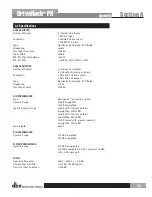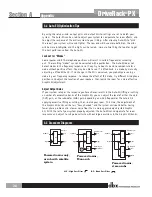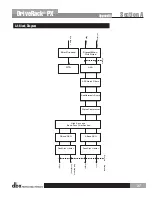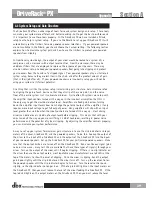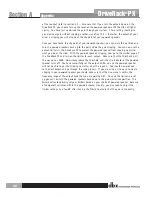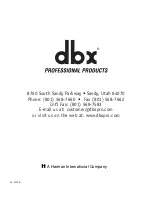
A.8 System Setup and Gain Structure
The DriveRack PX offers a wide range of tools for sound system design and setup. These tools
can make your system more efficient and better sounding, but to get the best possible sound
it is important to use these tools properly. In the DriveRack PX we have included a Wizard
setup tool to help in system setup. If you use the Wizard to set up your DriveRack PX it will
automatically set the limiters for some powered speaker selections. If your powered speakers
are not available in the Wizard, you should choose the Custom setting. The following section
explains how to maximize system gain and how to use the limiters to protect your powered
speakers from clipping.
In traditional system design, the output of your mixer would be routed to a system EQ, a
compressor, and a crossover with output level control. From the crossover, there may be
additional filters that are employed to improve the response of your speakers. There may
also be limiters set up to keep your powered speakers from going into clipping and protect
your speakers from the hazards of a clipped signal. Your powered speakers play a vital role in
system setup, because they are last item in the chain and offer the greatest amount of gain
(that is their job after all). If your powered speakers are incorrectly setup you will not be
using your system to its fullest potential.
One thing that is critical to system setup is maximizing gain structure. Gain structure refers
to aligning the gain of each device so that they all clip at the same point; and the noise
floor of the entire system is at its absolute minimum. Quite often PA systems are setup with
the amplifier input controls turned all the way up in the incorrect assumption that this is
the only way to get the maximum output level. Amplifiers are fixed gain devices, turning
down the amplifier input levels does not change the potential output of the amplifier; it only
requires more input voltage to get full output power. Many amplifiers will clip with an input
level greater than +6 dBu when the input controls are turned all the way up. Most mixing
mixers can deliver over +18 dBu of output level before clipping. This means that with your
amps tuned all the way up you are sacrificing 12 dB of headroom, resulting in poorer noise
performance and the potential of system clipping. By adjusting the amplifier controls properly,
you can maximize your system performance.
A way to set up your system for maximum gain structure is to use the clip indicators and level
meters of the mixer, DriveRack PX, and the powered speakers. To do this, hookup the output of
the mixer to the input of the DriveRack PX and the outputs of the DriveRack PX into the inputs
of your powered speakers. Set up the DriveRack PX for your particular powered speakers. Make
sure that the output limiters are turned off on the DriveRack PX. Run a continuous signal (pink
noise or sine wave – many test CDs are available that have these types of signals) through your
mixer. Turn up the output of the mixer until it begins clipping. If there is no clip indicator on
the mixer then use the output meters; most reputable mixer manufacturers use red LEDs at the
top of the meters to show the onset of clipping. Once the mixer is clipping, back the output
gain down slightly until the clip indicator on the mixer turns off. Turn up the level control on
the powered speaker until the clip indicator begins to turn on. Turn the level control down
slightly, so the clip indicator no longer is on. If the top red LED lights on the input meters on
the DriveRack PX, then you must reduce the level of the mixer feeding the DriveRack PX. If the
top red LED lights on the output meters on the DriveRack PX, then you must reduce the level
DriveRack
®
PX
Section A
Appendix
®
Summary of Contents for DriveRack PX
Page 1: ...User Manual Powered Speaker Optimizer Featuring Powered Speakers PX ...
Page 45: ......
Page 46: ......
Page 47: ......











